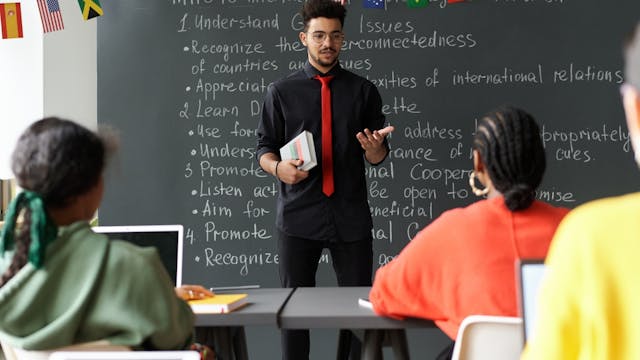Do you recall Mr. Lorensax from “Ferris Bueller's Day Off”? Anyone? Bueller? With his monotone voice and lack of enthusiasm, he could convince anyone that history is incredibly boring. Unfortunately, this portrayal isn't unique and reflects a broader issue with how social studies is perceived.
As a high school history teacher, whenever I meet new adults and we talk about our professions, I often find myself being met with a familiar reaction: "I disliked the subject in school, but now I find it interesting." I always wonder why that is the case. I think it might be because of a misconception, often exacerbated by movies, that history must be boring because it’s filled with dates, people and places which often require rote memorization. However, if taught with the intent to inspire and engage, history is far from boring or monotone.
While teachers cannot always avoid this perception, one thing is clear in my experience: to capture students' attention, we must make history more engaging.
Start with the Lead
I think that one of the reasons history teachers lose students’ interest is because the details of a lesson can get monotonous. I, too, have been guilty of urging my students to be patient, assuring them that the content is about to get interesting, but first, we need to get through these details.
While this approach may work with students who are intrinsically motivated to learn history, it's difficult to get through topics like the Pan-Slavic movement in the mid-19th century with uninterested 14-year-olds. These details can seem distant and abstract, especially if a student doesn’t understand the relevance or significance of the subject matter to their own life. Students may struggle to engage with the material without a clear understanding of the context or a perceived payoff for their attention.
The key is to start with the lead. Rather than explaining Balkan nationalism, start with the assassination of Franz Ferdinand, which provides an immediate point of interest and relevance for students. This approach is similar to a TV crime show that reveals the body in the first minute and then spends the rest of the show assembling evidence. By starting with a dramatic event that serves as a hook to draw students into the broader historical narrative, teachers can then make the details more engaging for students.
This approach also mirrors the approach that journalists take. In their book, “Made to Stick”, Chip and Dan Heath reveal that journalism students often overlook the lead of a story by focusing too much on trying to understand every detail. To counter this, teachers emphasize the inverted pyramid style, which prioritizes placing the most crucial information at the beginning of the article, or even in the headline. Taking this approach and starting with the headline, “Austrian Heir and His Wife Shot to Death After Escaping Bomb” is certainly more interesting than building a timeline of information up to the event.
Allow Students to be the Investigators
After I start with the lead, I like to spend time allowing my students to become the investigators. From what I’ve seen, I think it sustains their interest. A big idea related to World War I is the sinking of the Lusitania—a catalyst for U.S. entry into the war. Torpedoed in May 1915, it caused almost 1,200 civilian casualties but the U.S. declared war on Germany in April 1917. In our discussions, I ask students to explore the two-year gap: What happened during this time? How did public opinion evolve?
A crucial question regarding the sinking of the Lusitania is why. The Lusitania, a passenger ship, carried 173 tons of war munitions. According to Germany, it was a naval vessel — and a legitimate military target. Once my students discovered a discrepancy in how the ship was classified, I extended the activity by facilitating a debate, assigning points of view between the Allies and Germany, and debating whether the Lusitania was a military target. Throughout this lesson, my students not only learn the content but also develop critical thinking skills as they analyze evidence, put together persuasive arguments and respectfully debate their peers.
In my experience, allowing students to investigate historical events can increase their engagement because it appeals to their inherent curiosity. It gives them an opportunity to become active participants and take ownership of their learning. By providing a structured framework for inquiry, an approach often called guided inquiry, I guide students through the investigation process, offering resources, facilitating discussions and providing support as they build historical context and understanding.
Focus on the Stories of Individuals
I think another reason that students aren’t engaged in learning history is because it sometimes feels like we are so far removed from the people it happened to. We, as teachers, also often fail to appeal to the emotion of events as they happen.
Conversely, this is another reason why we tune into TV crime shows; beyond the suspense, they appeal to us because of their emotional elements. Characters often debate investigative strategies, and some have personal connections with the victim. These elements, intentionally included by writers, resonate with my sense of empathy, compelling me to form an emotional connection with the show.
Adding historical narratives into my lectures is something I always try to do in my classes to expose students to the experiences of individuals and help them foster those emotional connections. Consider this: In 1918, Congress passed the Sedition Act, forbidding “disloyal language” about the U.S. government. While a significant suppression of free speech, I usually bypass the law at first and narrate Eugene Debs' story. His June 1918 speech resulted in a ten-year prison sentence. Ponder that — ten years in prison for a speech; what could the speech have been about to warrant such a lengthy sentence? Students now question and eagerly await answers. Achieved through direct instruction, presenting big ideas first engages students for subsequent details in many social studies classrooms.
I often weave these historical narratives into content through primary sources. This breaks up my lectures and allows students to zoom in on a real person who experienced a historical period. Describing what trench warfare entailed is one thing, but reading a firsthand account of a soldier who lived through it — exposed to rats and standing in frigid water amidst piled-up bodies — is another. This history is inherently dramatic and engaging; teachers simply need to tap into these powerful stories.
Make History Personal

I love using primary sources and personal narratives to make history more relevant for my students, but that takes second place to tangible pieces of history like my family artifacts, such as my great-grandfather's World War I uniform. Students are intrigued by the wool fabric's weight, the helmet's dent, and the cut-up piece of the American flag. I also have my other great-grandfather’s World War II journal, detailing his time as a prisoner of war in northeast Germany. Reading his accounts, students connect with his story as it feels close to home. Introducing these artifacts often prompts students to share their own, creating a powerful, emotional experience.
I also invite students to bring in their own artifacts for a show and tell. When I establish links to my family history, my students feel more comfortable sharing their own. If you want to see engagement in your classroom, invite students to go home and discuss with their family about a link to a historical event, then have them share their stories with the class.
To echo the Heath brothers, incorporating emotion renders stories more memorable—they consider emotion the glue-binding stories. This emotional resonance is a hallmark of exceptional historical movies. Tapping into emotion not only enhances student attentiveness but also fosters longer-lasting content retention.
By embracing these engaging methods, history becomes inherently engaging and dramatic in the best way. Infusing these dynamic elements into history classes can cultivate a lasting passion for comprehending the past and its profound impact on the present and future.
And hopefully, in the foreseeable future, mentioning that I teach history might elicit a different response and more people will start telling me, "That was my favorite class in school!"


